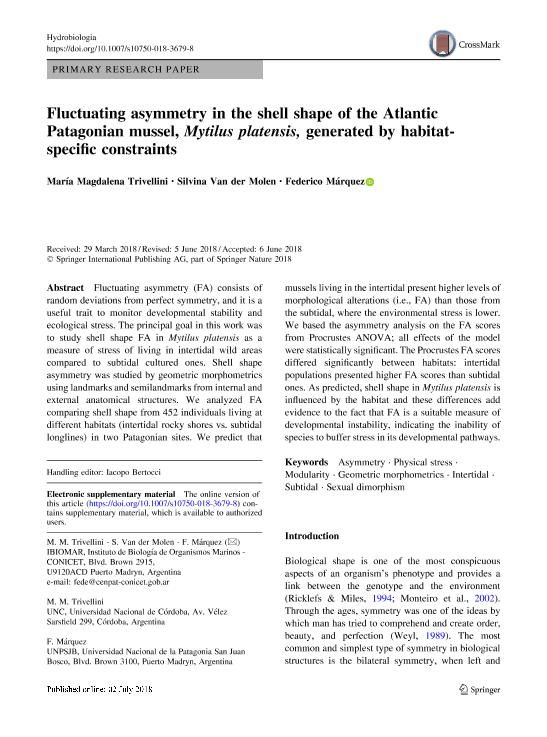Artículo
Fluctuating asymmetry in the shell shape of the Atlantic Patagonian mussel, Mytilus platensis, generated by habitat-specific constraints
Fecha de publicación:
10/2018
Editorial:
Springer
Revista:
Hydrobiologia
ISSN:
0018-8158
Idioma:
Inglés
Tipo de recurso:
Artículo publicado
Clasificación temática:
Resumen
Fluctuating asymmetry (FA) consists of random deviations from perfect symmetry, and it is a useful trait to monitor developmental stability and ecological stress. The principal goal in this work was to study shell shape FA in Mytilus platensis as a measure of stress of living in intertidal wild areas compared to subtidal cultured ones. Shell shape asymmetry was studied by geometric morphometrics using landmarks and semilandmarks from internal and external anatomical structures. We analyzed FA comparing shell shape from 452 individuals living at different habitats (intertidal rocky shores vs. subtidal longlines) in two Patagonian sites. We predict that mussels living in the intertidal present higher levels of morphological alterations (i.e., FA) than those from the subtidal, where the environmental stress is lower. We based the asymmetry analysis on the FA scores from Procrustes ANOVA; all effects of the model were statistically significant. The Procrustes FA scores differed significantly between habitats: intertidal populations presented higher FA scores than subtidal ones. As predicted, shell shape in Mytilus platensis is influenced by the habitat and these differences add evidence to the fact that FA is a suitable measure of developmental instability, indicating the inability of species to buffer stress in its developmental pathways.
Archivos asociados
Licencia
Identificadores
Colecciones
Articulos(IBIOMAR)
Articulos de INSTITUTO DE BIOLOGIA DE ORGANISMOS MARINOS
Articulos de INSTITUTO DE BIOLOGIA DE ORGANISMOS MARINOS
Citación
Trivellini, Maria Magdalena; Van Der Molen, Silvina; Marquez, Federico; Fluctuating asymmetry in the shell shape of the Atlantic Patagonian mussel, Mytilus platensis, generated by habitat-specific constraints; Springer; Hydrobiologia; 822; 1; 10-2018; 189-201
Compartir
Altmétricas




